|
Antique Important Large Anglo Indian ivory and Sadeli mosaic sewing/writing box C.1845.
Please click on images to enlarge | slide show | thumbnail index |
Reference: Sb400
Description:
Important large Anglo Indian fully fitted sewing and writing box of
pyramided shape veneered with ivory profusely inlaid with sadeli
mosaic, the box having swan neck handles to the sides and standing
on cast paw feet of unusual design. Inside the box is compartmentalized
and fitted for sewing, with fragrant sandalwood and has supplementary
lids and trays each veneered with ivory inlaid with sadeli,
circa 1845.
Provenance: sold in dispersal of contents of Manydown Park previous home
of Jane Austen's momentary fiancée.
Origin: India
Circa: 1845
Materials: Sandalwood
ivory ebony rosewood and metal.
Size: 44.5 cm wide by 29 cm by 16 cm (including
feet): 17.5 inches wide
by 11.4 inches by 6.3 inches (including feet
(including feet).
Condition: very good
original condition. Small loses and blemishes which have been
consolidated. Please look at large images which are accessed by clicking
on the smaller. Working lock with original key.
|
.JPG)
The inlay is rich and complex, and yet remains totally controlled. A
box of this high quality represents hundreds of hours of master
craftsman work.
|
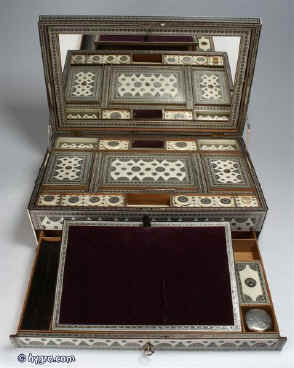
|
The box opens to a complex
interior.
The upper part is fully
fitted for sewing with supplementary lids and turned ivory thread
barrels, all profusely inlaid.
There is a framed mirror in
the lid with a velvet covered compartment behind.
There is a drawer to the
front which contains a fully fitted writing slope. The writing surface
is covered with Tyrian purple velvet.
The fast, non-fading purple dye was an item of
luxury trade, prized by Romans,
who used it to colour ceremonial robes. Pliny
the Elder described the dyeing process of two purples in his Natural
History[2]:
"'... the Tyrian hue ... is considered of the
best quality when it has exactly the colour of clotted blood, and is
of a blackish hue to the sight, but of a shining appearance when held
up to the light; hence it is that we find Homer speaking of
"purple blood'."
From Wikipedia we learn:
"Tyrian purple (Greek:
πορφύρα,
porphura), also known as royal purple or imperial purple,
is a purple-red dye
made by the ancient Canaanites/Phoenicians
in the city of Tyre,
from a mucus-secretion of the hypobranchial gland of a marine snail
known as Murex
brandaris or the Spiny dye-murex.
A synthetic purple was not
developed until the early 20th C.
|
Please click on images to enlarge | slide show | thumbnail index |
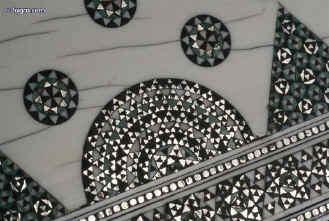
|
Ivory, pewter, rosewood ebony and stained ivory were
cut into faceted rods which were bound together to form geometric
patterns. When the glue had set, the rods were sliced in transverse
sections. This gave the maker a number of angled circular pieces in the
original pattern. Several variations of patterns could be achieved by
combining the materials in different ways. The ivory was sometimes dyed
green as here to give an extra colour.
|
The ancient art of sadeli
Mosaic is said to have been introduced from Shiraz in Persia via Sind to
Bombay, a long time before the Anglo Indian boxes were made. It was a
technique, which required a high degree of skill and patience. It was
executed very lavishly, in that the frequent cuts wasted a great amount
of the precious materials used. The workmanship was however more than
commensurable to the value of the materials.
The superb craftsmanship is
evident in the control of the patterns in the complex corner joints with
mitered and specially shaped elements.
|
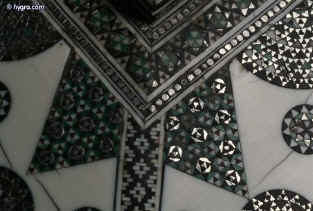
|
Please click on images to enlarge | slide show | thumbnail index |
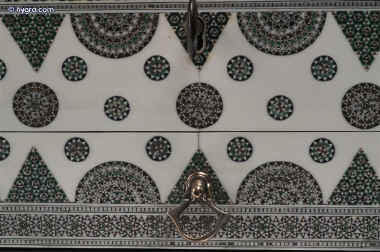
|
The symmetry of the patterns is astonishing;
this is strongly demonstrated by the sharpness of the points of the triangles.
It is interesting to also note that the front is made of two pieces of
ivory. The barely visible join running from the escutcheon to the drawer
handle is evidence of complete mastery of materials.
|
Please click on images to enlarge | slide show | thumbnail index |
Detail: cast paw feet of
unusual design
|
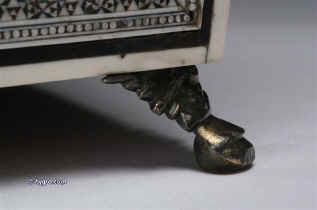
|
Please click on images to enlarge | slide show | thumbnail index |
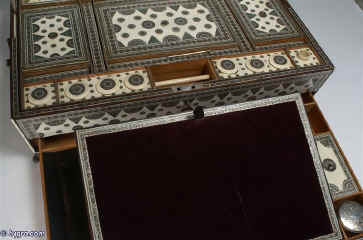
|
There is a drawer to the
front which contains a fully fitted writing slope. The writing surface
is covered with Tyrian purple velvet.
The pen tray is curved and
made of solid ebony.
|
Please click on images to enlarge | slide show | thumbnail index |
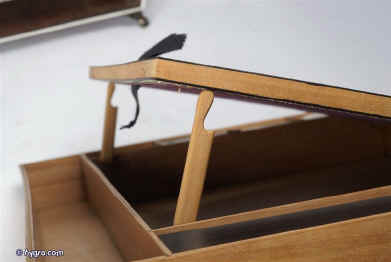
|
Detail: there are sandalwood risers for raising
the writing surface to a slope.
|
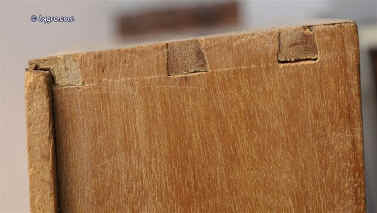
|
The drawer is made of sandalwood which still retains
its perfume. The construction uses had cut dovetail joints. The original
craftsman's scribed marking line is just visible.
|
Please click on images to enlarge | slide show | thumbnail index |
Please click on images to enlarge | slide show | thumbnail index |
The orchestration of the pyramided top with
tapered plains is truly amazing. The design works and is a delight in
both a totality and in the minutia.
|
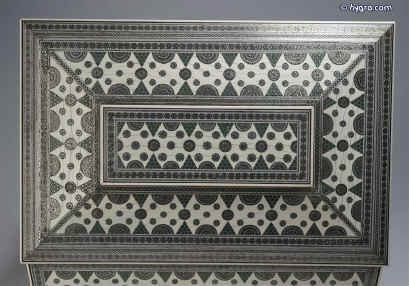
|
Please click on images to enlarge | slide show | thumbnail index |
Please click on images to enlarge | slide show | thumbnail index |
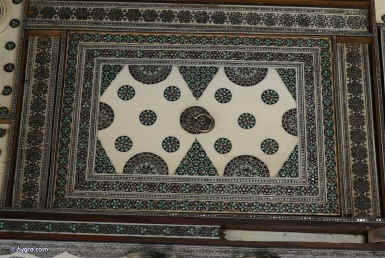
|
Detail: one of the supplementary
lids. Inside the box is profusely inlaid with sadeli
mosaic.
|
Please click on images to enlarge | slide show | thumbnail index |
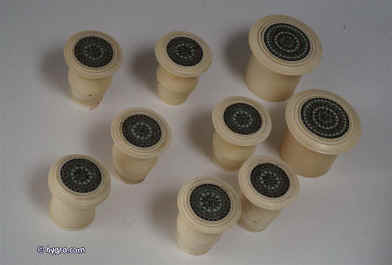
|
The box has a set of six turned ivory thread barrels
and two cylinder shaped boxes and a further turned holder for a silk
tape measure. Each is decorated with a circle of sadeli
mosaic.
|
Please click on images to enlarge | slide show | thumbnail index |
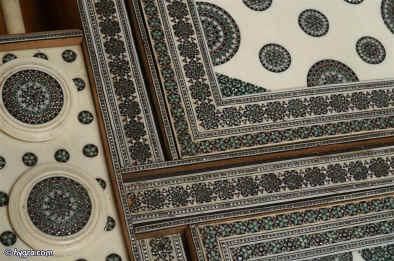
|
The whole interior is extensively inlaid. |
Detail of one of the cylinder boxes in situ.
|
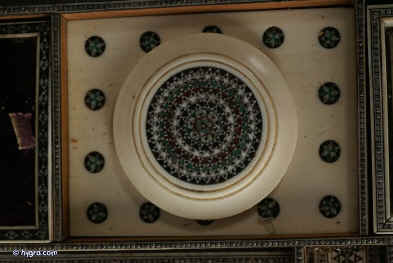
|
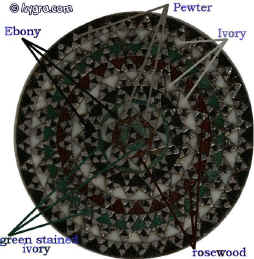
|
Detail of the inlay on the top of one of the turned
circular boxes. The inlay combines ivory ebony rosewood and pewter.
The makers (reputed to be
Persian) of Sadeli mosaic displayed a total understanding of the
qualities of the different materials they used. They combined
substances, which can expand and contract according to atmospheric
conditions with others, which are hard and unyielding. The result was a
sharp definition of the lines and patterns, which made up the whole
design.
|
Please click on images to enlarge | slide show | thumbnail index |
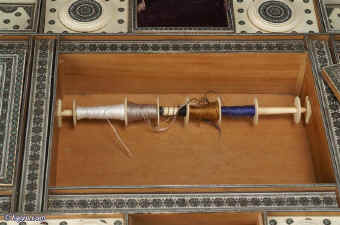
|
Beneath one of the supplementary
lids there is a turned ivory bobbin with divisions for several
coloured threads.
|
The drawer is kept in place by a pin which goes
through the facing to the right of the lock.
|
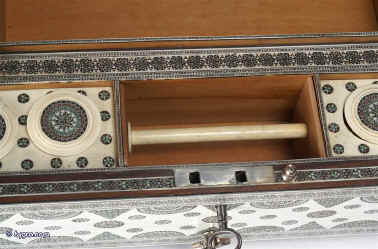
|
Please click on images to enlarge | slide show | thumbnail index |
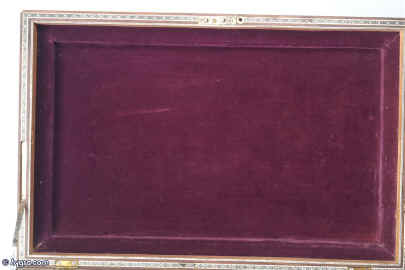
|
There is a further compartment in the lid behind the
mirror which is lined with purple velvet.
|
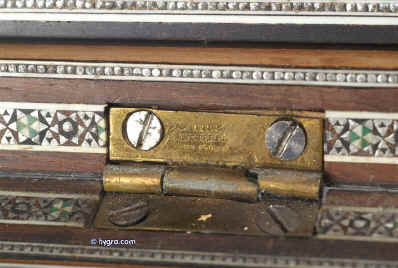
|
The hinges are particular and have a complex stopping
mechanism.
The hinges are stamped P. Moore, Registered Sept. 1845.
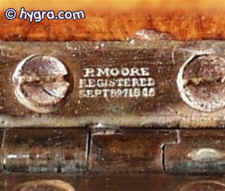
We have seen this hinge on another quality box, a tea chest:
|
Please click on images to enlarge | slide show | thumbnail index |
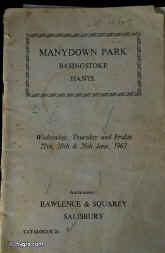
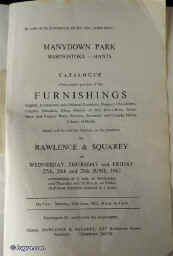
|
Inside the box was an Auction Catalogue which
shows that the box was sold as part of the contents of Manydown Park in
1962.
Manydown Park witnessed an interesting literary
incident in its past.
History records that on the night of Thursday 2
December 1802 when Jane and Cassandra were staying at Manydown Park,
Harris proposed to Jane
Austen. Jane accepted his proposal but the next morning decided to
break the engagement off. That led to a confrontation ending in the
Austen sisters demanding that their brother James must abandon his
duties as a clergyman and escort them back to Bath.
|
Please click on images to enlarge | slide show | thumbnail index |
Please click on images to enlarge | slide show | thumbnail index |
| The entry in the auction catalogue reads.
"Lot 469. An Indian inlaid ivory work-box with dome cover, 17in. x
11in." |
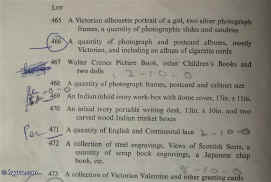
|
Please click on images to enlarge | slide show | thumbnail index |
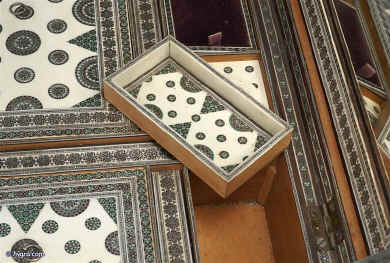
|
Very few craftsmen could have
worked to such high standards, even allowing for perfect eyesight and
steadiness of hand. Special sadeli boxes found their way to
the grand aristocratic houses in England .
Queen Charlotte, the wife of George
III owned three.
|
Please click on images to enlarge | slide show | thumbnail index |
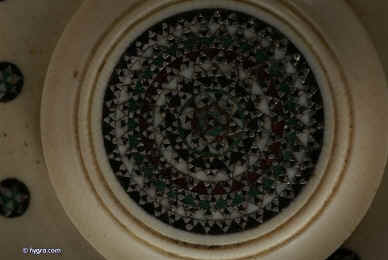
|
The work spread to other centers in the Bombay
Presidency and by the middle of the 19th century, an enterprising Parsee
(Persian) introduced the work to Calcutta and sent some boxes to the
1851 London Great Exhibition. The Calcutta work consisted of sadeli
patterns set into wood and ivory.
|
Please click on images to enlarge | slide show | thumbnail index |
| This is an exceptionally large and impressive box.
|
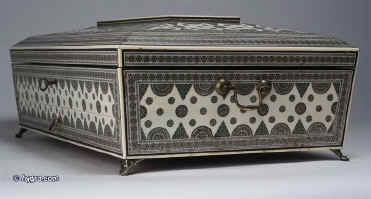
|
Notes and links:
http://www.pemberley.com/jasites/jasites.html
Manydown
Home of the Bigg Withers. In 1802, Jane Austen received,
accepted and then rejected a proposal of marriage from Harris Bigg Wither at
Manydown Park.
http://www.bigg-wither.com/People/Harris_Bigg-Wither_1781-1833.htm
Harris Bigg-Wither (18 May 1781–23 March 1833)
was a wealthy English country gentleman who stood to inherit Manydown Park and
other land holdings in the parish of Wootton St Lawrence in Hampshire. It was at
Manydown Park in 1802, that Jane
Austen received, accepted, and then rejected, a proposal of marriage from
Harris Bigg-Wither.
Manydown Park was a mansion with one wing dating back to the
Tudor times, but a modernized interior with an elegant staircase leading to a
grand first-floor drawing room which had a large bay window overlooking
impressive grounds. Beyond were farm lands of 1,500 acres. The Manydown Park
mansion was pulled down in 1965.
History records that on the night of Thursday 2 December 1802
when Jane and Cassandra were staying at Manydown Park, Harris proposed to Jane
Austen. Jane accepted his proposal but the next morning decided to break the
engagement off. That led to a confrontation ending in the Austen sisters
demanding that their brother James must abandon his duties as a clergyman and
escort them back to Bath.
http://www.jasna.org/persuasions/printed/number10/honan.htm
She was warned by
Cassandra, who at last found the right suitor for her at Sidmouth, a clerical
gentleman who died before he could be seen again.
Soon after the Sidmouth affair, on December 2, 1802, at Manydown Park,
Jane Austen agreed to marry Harris Bigg-Wither.
We have reliable evidence of that.
She
was almost 27. He was 21 –
overgrown, with a stammer, a big, timid, stuttering, red-faced man.
For
further information on Jane Austen:
Jane
Austen's House Museum
http://www.jane-austens-house-museum.org.uk/
The
Jane Austen Society
www.sndc.demon.co.uk/alslist.htm#JA
A great
private site with information
http://www.lang.nagoya-u.ac.jp/~matsuoka/Austen.html
All text and images and linked images are ©
1999-2008 Antigone Clarke and Joseph O'Kelly. If you require any further
information on permitted use, or a licence to republish any material, email us
at copyright@hygra.com
| 